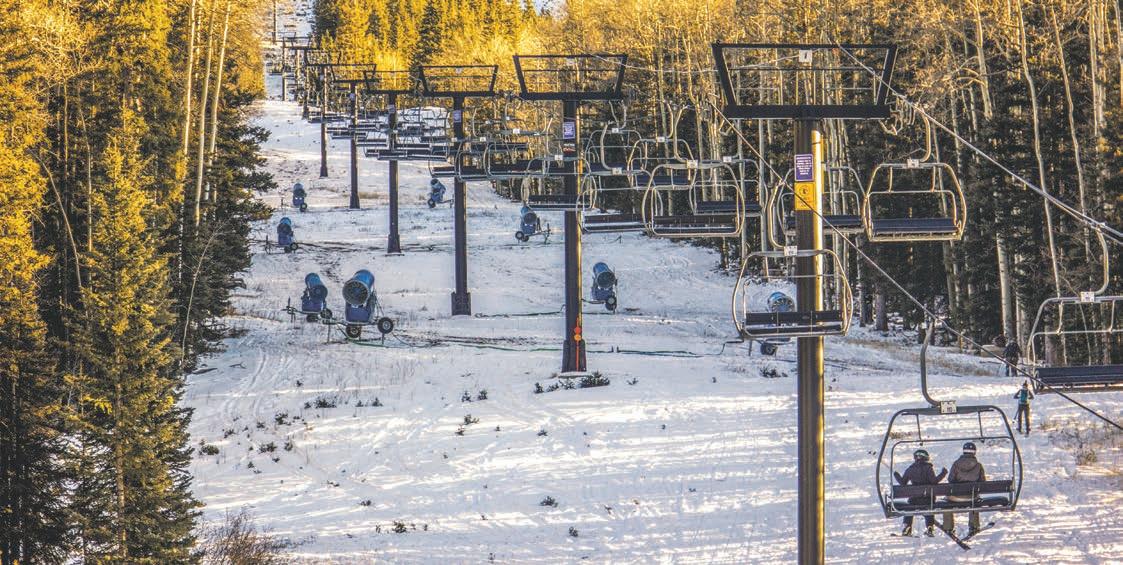
9 minute read
SEASONABLY WARM
Skiers head up for a final run on Monday at Ski Santa Fe, its third day open this season.
Hotter winters—a symptom of climate change—take a toll on New Mexico’s skiing industry; bleak forecast ahead
Advertisement
BY WILLIAM MELHADO william@sfreporter.com
It’s almost a crime to complain about the long parade of cloudless, sunny, 55-degree days as Santa Fe rolls into December, but the inconvenient culprit behind the idyllic weather is well known.
While the souring of Earth’s atmosphere fueled wildfires to the west and hurricanes to the east this summer, part of New Mexico’s reckoning with climate change comes in the form of warmer winters—and with them a cascade of issues for an industry that relies on snow.
A stretch of get-me-outside-right-now days in the early winter aren’t prima facie evidence of climate change but, for Tommy Long, Ski Santa Fe’s operations manager, hotter winters mean the beginning of the season often relies on man-made snow.
“Mother Nature provides, kind of, what she can provide, and we do our best to supplement it with the snowmaking,” Long tells SFR.
Thankfully for Ski Santa Fe, the weather cooperated this year, staying below freezing long enough to produce enough snow for the opening day of the 2021-22 season on Nov. 25, with five runs on the mountain suitable for shredding.
The ski area installed a $2.2 million water tank in 2015 to store some of the millions of gallons of water the state engineer allows the resort to divert. Some years, the resort uses more or less of that water to make snow. Long tells SFR the expenses for making snow—such as labor and fuel—have increased, which in turn has contributed to higher lift ticket prices in recent years.
Over in Los Alamos, another Long, with almost six decades of experience in New Mexico’s ski industry, says there’s been a shift in how resorts manage snow since he first started working at Sandia Peak Ski Area in 1966.
Tom Long, Tommy’s father and general manager of Pajarito Mountain Ski Area, says warmer winters are reflected in how many New Mexico ski areas rely on snow making.
That’d be all of them, the elder Long says.
We “spend a lot of time craning our neck at the heavens and you try to look at weather patterns, and what’s going on, and if it’s an El Niño or La Niña [year],” he says. And ultimately “we can do our part to help mitigate issues with the weather, but the weather is what it is.”
Both Longs explain that some winters are better than others, and they’re keeping their fingers crossed for colder months ahead.
But one especially cold, or warm, winter shouldn’t distract from the larger picture of warming seasons the ski industry faces.
New Mexico State Climatologist David DuBois says the trend isn’t new and doesn’t show any signs of reversing.
“Since right around 1970 we’ve seen an upward trend, in pretty much all the areas in New Mexico, of warming temperatures,” DuBois tells SFR. He adds that the average increase in temperature ranges from 0.5 to 0.8 degrees Fahrenheit per decade.
According to data compiled by Climate Center, an environmental research organization, the average winter temperature in the Albuquerque and Santa Fe region increased by three degrees in the last 50 years.
This warming, tied to the billions of metric tons of energy capturing carbon dioxide and methane released into the atmosphere each year, reflects just a portion of the consequences climate change brings to New Mexico, explains DuBois.
As the atmosphere warms, precipitation falls more often as rain, instead of snow, says DuBois—an effect observed both in early winter and the spring. One implication, he explains, is an earlier “melt out,” when water flows out of the mountains prematurely.
Also with the higher temperatures, additional evaporation moves the water into the atmosphere, DuBois says. That’s not what New Mexico needs. “We want it to stay in the ground and travel down the streams so that we can use it in acequias and store it in reservoirs and eventually for agriculture, for ecosystems,” DuBois says.
Another indicator of New Mexico’s shifting climate is the number of winter days above “normal” temperatures. Albuquerque and Santa Fe’s last winter season had 12 more days when weather was warmer than that average, based on data from the National Oceanic and Atmospheric Administration and National Centers for Environmental Information.
DuBois explains that total precipitation for the region isn’t changing significantly, but the increases in temperature have the biggest impact on snowpack and surface water supplies.
A winter sports enthusiast, DuBois says the impact of climate change on Northern New Mexico’s winters will force industries like ski resorts to adapt.
The elder Long says one adaptation he’s observed in the ski industry is snow farming.
In New Mexico, Long explains, everyone is a good snow farmer. When he started in the ski industry, before the warming trend noted by DuBois, there was some grooming and moving of snow to take care of it, “but man, it’s gotten way more sophisticated with the type of equipment we use now to groom the snow,” says Long.
Using snow fencing and snowcats, Long says, resorts solidify their snowpack, taking the air out to reduce how much melting occurs.
The younger Long adds that ski areas model the practices of agriculturalists in another way: “Like farmers keep an eye on the rain, we keep an eye on the weather very closely.”
His team at Ski Santa Fe uses weather stations on site that gather data to look ahead to best predict the weather.
2021

NONFICTION / THEME: WHAT WE OWE
The theme for SFR’s 2021 Writing Contest nonfiction category came from one staffer’s recent reading of What We Owe to Each Other, by philosopher T M Scanlon. We envisioned entries that might opine on how to rebuild the fractured society in which we find ourselves, and though the responses struck our guest judge as unconventional, she also found them “deep.”
“They were just totally different approaches than I would have thought of,” says former state senator Dede Feldman, whose memoir, Ten More Doors: Politics and the Path to Change published this fall. “My response was far more mundane. Wear a mask...something tangible. These essays were so much more than that.”
Indeed, first-place winner Janna Lopez rejected the theme altogether but did so in a way that leaves readers pondering significant questions. Second place Joe Cooke presents the questions of Japanese Naikan, and sentences ending in question marks are even pervasive as Jackson Buckley deconstructs selfhood.
Later the poet admonished readers to “live the questions.” We’re down with that. (Julie Ann Grimm)
1st
BY JANNA LOPEZ
What We Owe.
What a peculiar prompt. First proper ode to the notion of owing.
I read the literal definitions of ‘owe’ and my chest hurts. Although I’m aware of what the word means, the implications—the weight of what’s behind the word—suffocates. Most don’t aspire for a reality of debt. The overwhelm of expectation closes in walls, closer and closer, until there’s no room to breathe. Wherever debt derives from, requirement’s swallow is stifling.
I get the initial implication of the prompt; as stated, this prompt could be interpreted as the collective owing. What we owe society? What we, as humans, owe one another?
More closely contemplated, aside from standard bills and responsibilities required of daily life, or the IRS, whom or what might we owe?
God
Religion
Community
Children
The past our ancestors historical grievances
The present
The future
The afterlife
Environment
Our body
Our Mind
Our Soul
Our Selves…
Do you feel you owe anything, or of your Self, to any of the above? To all of the above?
I wonder about obligation’s burden that presses upon us throughout our lives. We spend so much of our precious time striving to pay or repay debts of various kinds, including social, moral, religious, and cultural debts. Do we wake up alive, gifted into our being, birthed into debt? That’s a depressing thought.
If I look back on childhood, experiences that shaped me, like many of you, I recall the people who helped me connect, explore, learn, discover, or uncover invaluable insights that became embedded into who I am. Many names I can’t remember, yet I feel indebted to them, nonetheless. But not in the owing sphere of the word. The indebtedness I speak of relates more to gratitude than obligation.
The kind teacher who taught me how to read and write. The doctor who gave me stitches when I was stabbed in the chest with scissors when I was in first grade. The school bus driver with a missing front tooth who warmly greeted me as I got on the bus, and widely smiled as if he had a full set of teeth. The uncle who slipped me dollar bills at family parties. Boyfriends who taught me the true meaning of how to love myself through their rejection. Friends who extended their shoulders for tears, their wisdom, their encouragement. Records whose music became magic for the soundtrack of my life as I played them over and over again. Moments in which gestures were seen as currency of connection, not as favors of condition.
I don’t believe the purpose of life is to fulfill obligation—as in we owe. That would mean servitude, and servitude disparages the realm of service. To give. Because the heart can’t help itself from expressing love. Because it can. Not because it has to. What about those who don’t feel this way? Does a requirement of servitude make up for a gap caused from the less altruistic? Is there some karmic balance in our order of existence?
When I imagine who gives, who serves, who shares, who contributes, I witness how people do as they can. In ways that they can. I don’t get the sense that they give or serve, share or contribute, because they’re doing so out of owing. It’s not to say they may not hold a moral, religious, or social consciousness about helping fellow humans, but the origin from which they give comes from a place of wanting to give, not having to give.
Not everyone is capable. It is from the wellspring of our humanness that we provide. How can we pay something owed, if we ourselves have empty pockets? Socially, we’re inept. Have you considered how flawed, afraid, and fractured the source—i.e. our humanness—is? Expecting a complete clearing of a psychic, spiritual, or cultural contract, is a willful set up for failure. Reckless at worst. Selfish at best.
How might we love one another?
How might we extend compassion?
Might we be kind?
Might we extend thoughtfulness?
Seems the division of our times stems from false indignation.
Entitlement.
The very indoctrination of owing and being owed.
People feel they’re owed some form of social bounty; a bounty that fulfills selfish ideals—ideals that mirror their own skewed righteousness.
The shouting among us is palpable.




